Keywords
|
| Mobile ad hoc networks (MANETs), power varied nodes, virtual clustering, routing. |
INTRODUCTION
|
| Mobile ad hoc network (MANET) is a self-configuring,infrastructurelessnetwork of mobile devices connected by wireless and can change locations as shown in fig 1.1. Nodes in MANET can communicate with each other and can move anywhere without restriction. Mobility is not restricted and characteristics of MANETs are easily deployable, so they are very popular and suitable for emergencies, natural disaster and military operations.Movable network consists of devices with different characteristics in terms of transmission power, means it’s an ability of lower power nodesto receive transmissions from higher power nodes but reverse is not true. A cross layer framework offers a simple and effective approach for media access control and supports routing in power varied ad hoc networks. By this the overall throughput of the power varied network is improved by 25 % over traditional layered approaches[1]. |
| The benefits of high-power nodes are the expansion of networkcoverage and also have advantages in power and data transmission rate. So, researchers have made efforts to examine these advantages, like backbone construction i.e., virtual backbone is constructed in a distributed and localized fashion while considering many incompatible objectives like fast convergence, and low computation cost [2] . Topology control helps in conserving the energy by either reducing transmission power per node or preserving energy-efficient routes for the entire network [3]. But, the large transmission range of high powernodes leads to large interference, which reduces the spatial utilization of network channel resources.Because of different transmission power, unidirectional links will occur in MANETs.Hence our aim is to replace unidirectional links with bidirectional links. |
| Many routing protocols in power varied MANETs are designed only to find the unidirectional links and to avoid the transmissions based on these links without making use of the benefits of high-power nodes. The routing performance of power heterogeneous MANETs should be improved by considering the advantages and neglecting the disadvantages of high- power nodes. Hence, in this paper we proposed a loose- clustering-based (LVC)routing protocol for power varied MANETs, i.e., LRPH which achieves better throughput. We build LVC to detect unidirectional links by making use of the benefits of high power nodes. Clustering is a scheme to improve the performance of the network. In order to achieve optimized clustering, a hierarchical cooperationscheme is used. The number of hierarchical stages andthe related cluster sizes which maximize the total throughput is choosen. This scheme is applied for random networks by developing clustering algorithm in which the entire network is divided into quadrilateral clusters, eachwith equal number of nodes [7]. In the existing clustering schemes, each node in the network plays a certain role as cluster head, member, or gateway. Due to cluster formation, a hierarchical routing is done in which routes are recorded between clusters instead of between nodes. So, there is anincrease in route lifetime, thus decreasing the amount of routing control overhead [8].In our clustering scheme, a loose coupling relationship is established between nodes because the cost of cluster construction and maintenance decreases.High-power nodes are used for cluster formation but they are avoided for packet forwarding to reduce interference. |
RELATED WORK
|
| In [9] authorusedthe comprehensive summary of the routing protocols for MANETs in which the nodes are mobile, the network topology changes rapidly, affecting the availability of routing paths. So, important challenge in the design of algorithms for a mobile ad hoc network is that its topology is dynamic.Comparison of the performance of the following routing protocols AODV, CBRP, DSR, and DSDV are studied and compared based on mobility, load and size of the ad hoc network and the results shows that, CBRP has a higher overhead than DSR because of its periodic hello messages while AODV's end-to-end packet delay is the shortest when compared to DSR and CBRP [10].Examples of routing protocols for heterogeneous MANETs are MC (Multiclass) which is a position aided routing protocol for power varied MANETs. MC routing utilizesthe more powerful nodes as backbone nodes. The routing area is divided into many small, equal-sized cells and a B-nodeis maintained in each cell.Most of the routing activities (packet forwarding) are among B-nodes so, there is reduction in routing hop count and makes the routing more efficient and reliable, since B-nodes have large transmission range, and are more reliable.Then, a new MAC protocol, i.e hybrid MAC (HMAC), is designed to cooperate with the routing layer. Based on the cell structure and HMAC, MC achieves better performance[4]. Hierarchical optimized link state routing (HOLSR) is a routing protocol for large-scale heterogeneous networks and is defined as a network of movable nodes that are characterized by different communication capabilities like multiple radio interfaces. It is proposed to improve the scalability of OLSR and helps in reduction of routing control overhead in large heterogeneous ad hoc networks [5]. In [6] author used Device-Energy- Load Aware Relaying framework(DELAR) that focuses on energy conservation inheterogeneousMANETs consisting of powerful nodes and normal nodes . It achieves energy conservation from power-aware routing, transmission scheduling and power control. Our approach makes use of loose coupling relationship between nodes in cluster which is better than previous existing approaches. |
PROPOSED ALGORITHM
|
| We consider two types of nodes in the networks: B-nodes with highpower nodes and a large transmission range. Gnodes - low power with small transmission range. The number of B-nodes (Backbone nodes) and G-nodes(General nodes) are denoted as NB and NG, respectively and there transmission ranges as RBand RG, respectively. The state of G-nodes in the network is defined as Gisolated - G-node thatis not covered by any B-node. Gmember - G-node whosebidirectional neighbours (BNs) are covered by its cluster head. Ggateway - G-node whose BNs are not covered by its cluster head. |
| Abbreviation: |
| ? LVC: Loose Virtual Clustering |
| ? LRPH: Loose-virtual-clustering-based Routing protocol for Power Heterogeneous |
| ? BND: Bidirectional Neighbor Discovery |
| ? AN: Aware Neighbor |
| ? LAT: Local Aware Topology |
| ? GLI: G-node LVC Initialization |
| ? BLI: B-node LVC Initialization |
| ? TTL: Time to Live |
| ? CMR: Cluster Member Register |
| ? CHD: Cluster Head Declare |
| ? LR and GR: Local Routing and Global Routing |
| ? RREQ: Route Request |
| ? RREP: Route Request Replay |
| ? RERR: Route Error |
| ? DSR: Dynamic Source Routing |
| ? MC: Multiclass |
| A. LVC Algorithm |
| 1) BND:Unidirectional links are eliminated by discovering bidirectional links as shown in fig 3.a.1. BND packet consists of its own information ex: ID, type, state and the information on its discovered neighbors. |
| 2) LVC: |
| To derive benefits of B-node, LVC algorithm is designed. B-node is chosen as a cluster head to establish a loose coupling relationship with G-nodes. G-nodes (Gmember or Ggateway) which are covered by B-nodes will participate in cluster formation . LVC has two features: i) avoidance of overhead which is caused by reconstruction and maintenanceof the cluster when the B-node count is small. ii) Even though all G-nodes are in the Gisolated state, LRPH protocol is adaptive to the high number of B-nodes. Byexchanging control packets, all nodes build a local aware topology (LAT) table which stores a local topology information based ondiscovered bidirectional links. Construction of LVC is as shown in fig 3.a.2 |
| Received CMR packets and CHD packets are used to build LAT by all B-node, and all G-nodes resply. |
| 3) LVC Maintenance: |
| It is activated when the links between nodes fail, particularly when node ni detects any ofthe following conditions based on the periodical BND packets. |
| ? If node nidoes not receive the BND packet from node nj in the AN table within a specified time,nj should be out ofits coverage range. |
| ? If node ni receives the BND packet from node nj and nodenj is not in the AN table, a new link between ni and njshould be added. |
| LVC maintain by G-nodes: |
| Step1: G-node niupdates its node state, AN and BN tables. |
| Step 2: • If nj is the cluster head of ni, a new cluster head is acquired. Initially, nicalculates the path to the old cluster head conforming with LAT and then updates the topology information related to nj in LAT. Then,new cluster head is selected by ni.At last,nimulticasts CMR packets to both the new and old cluster heads nj. Now node ni registers to the new cluster head and notifies the old cluster that ni is out of the transmission range of nj . |
| • If nj is a B-node but not the cluster head of ni, ni leaves the coverage range of B-node nj , and niupdates the topology information on nj in LAT. |
| • If njis G-node and in the BN table, the bidirectionallink fails. Gmember or Ggateway nodes send the BN update (BNU) packet to the cluster head for updating the BNs. |
| Step 3: After recieving CMR packets, B-node broadcast CHD packets. If the cluster head receives BNU packets, it broadcasts BNU packets again in one hop. The G-node updates the cluster and LAT information in conformance with received packets. |
| LVC maintain by B-nodes: |
| Step 1: B-node niupdates LAT, AN and BN tables |
| Step 2: If njis in the BN table of ni,ni broadcasts BNU packets in one hop to update the LAT tables of all nodes within its coverage range. |
| 4) Cluster Head Selection: |
| The number of B-nodesin the AN table maintained at any G-node giis denoted by N . The cluster head of gi is found as shown in fig3.a.4 |
| B. Routing Components in LRPH: It includes route discovery and route maintenance. |
| 1) Route Discovery Procedure: If a source node S needs to send a data packet to destination node D,S first searches the path to D in its route memory, if soS directly sends the data packet else itactivates the route discovery procedure to discover a route to Das shown in fig 3.b.1. This procedure consists of the local routing (LR) and global routing (GR) components. |
| LR: The route to D will be directly obtained, ifD is in the LAT table. |
| GR: If D is not in the LAT table, S broadcasts a route request (RREQ) packet to discover the source route to D, after receiving the complete route to D, it replies with a route reply (RREP) packet to S. When Sreceives the RREP packet, it inserts the new route into its route cache and sends data packets. |
| Now a node obtains a complete source route to D, it replies with a RREP packet to S directly. Because the RREP packet is delivered using unicast, the bidirectional links will be used. If packets are forwarded through B-nodes, throughput of a network will be decreased, so weexclude B-nodes in the path by replacing B-nodes with multihop Gnodes. But thisscheme increases route hops and finally network throughput can be improved.A timer is set and if expires, drop the packet. If the route discovery fails for many times, data transmission will be cancelled. |
| 2) Route Maintenance Procedure:Whenevera link failure occurs and is detected by middle node through the BN table, the routemaintenance is activated. A route error (RERR) packet iscreated and sent to the source node along the reverse route.When any middle node (including the source node) along theroute receives the RERR packet, the route with the broken linkwill be removed from the routing memory. When the source nodereceives the RERR packet, a next round of route discoveryprocedure is activated. Expected results include three parameters - packet throughput, less packet delay and more packet delivery ratio and can be evaluated as shown in table 2.1, 2.2, 2.3. |
CONCLUSION
|
| Development of LVC-based routingprotocol named LRPH for power heterogeneous MANETs, improves the network throughput largely. We designed an LVC algorithm to eliminate unidirectional links and to benefit from highpower nodes in transmission range and reliability. We developed routing schemes to optimize packet forwarding by avoiding data packet forwarding through high-power nodes. |
Tables at a glance
|
|
|
Figures at a glance
|
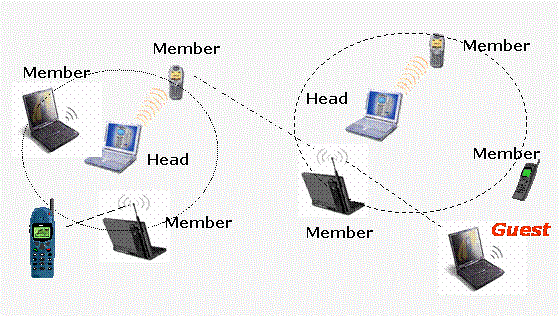 |
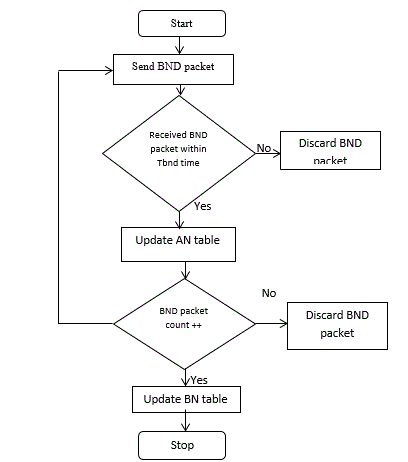 |
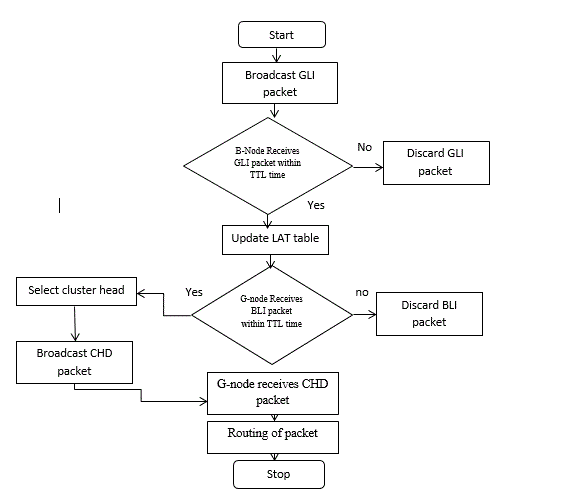 |
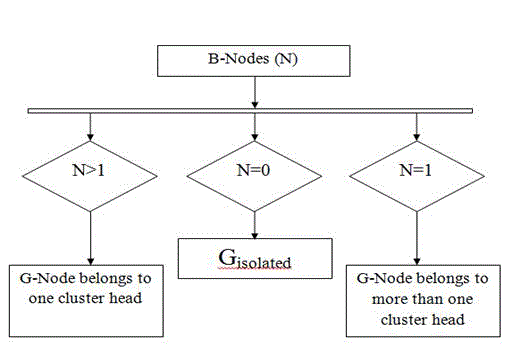 |
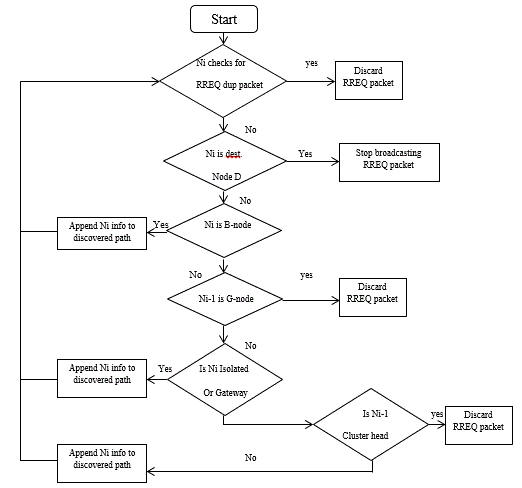 |
| Figure 1 |
Figure 2 |
Figure 3 |
Figure 4 |
Figure 5 |
|
References
|
- V. Shah, E. Gelal, and P. Krishnamurthy, “Handling asymmetry in powerheterogeneous ad hoc networks,” J. Comput. Netw.— Int. J. Comput.Telecommun.Netw. vol. 51, no. 10, pp. 2594–2615, Jul. 2007.
- J. Wu and F. Dai, “Virtual backbone construction in MANETs using adjustable transmission ranges,” IEEE Trans. Mobile Comput., vol.5, no. 9, pp. 1188–1200, Sep. 2006.
- A. A. Jeng and R.-H.Jan, “Adaptive topology control for mobile ad hoc networks,” IEEE Trans. Parallel Distrib. Syst., vol. 22,
- X. Du, D. Wu, W. Liu, and Y. Fang, “Multiclass routing and mediumaccess control for heterogeneous mobile ad hoc networks,” IEEE Trans.Veh. Technol., vol. 55, no. 1, pp. 270–277, Jan. 2006.
- L. Villasenor-Gonzalez, Y. Ge, and L. Lament, “HOLSR: A hierarchical proactive routing mechanism for mobile ad hoc networks,” EE Commun.Mag., vol. 43, no. 7, pp. 118–125, Jul. 2005.
- W. Liu, C. Zhang, G. Yao, and Y. Fang, “Delar: A device–energy–load aware relaying framework for heterogeneous mobile adhoc networkseous networks,” IEEE J. Sel. Areas Commun., vol. 29, no. 8, pp. 1572–1584, Sep. 2011.
- J. Ghaderi, L. Xie, and X. Shen, “Hierarchical cooperation in ad hoc networks: Optimal clustering and achievable throughput,” IEEE Trans.Inf. Theory, vol. 55, no. 8, pp. 3425–3436, Aug. 2009.
- J. Y. Yu and P. H. J. Chong, “A survey of clustering schemes for mobile ad hoc networks,” Commun. Surveys Tuts.,vol. 7, no.1, pp. 32– 48, First Quart., 2005.
- A. Boukerche, “Algorithms and Protocols for Wireless, Mobile Ad Hoc Networks”. Hoboken, NJ: Wiley, Nov. 10, 2008.
- A. Boukerche, “Performance evaluation of routing protocols for ad hoc wireless networks,” Mobile Netw. Appl., vol. 9, no. 4, pp. 333– 342, Aug. 2004.
|